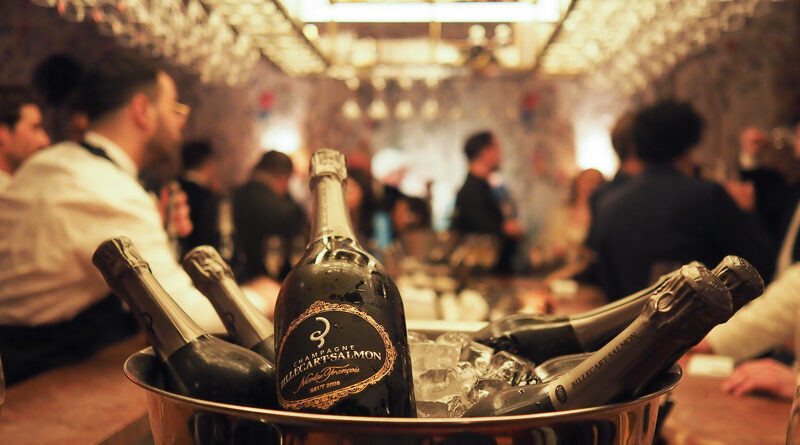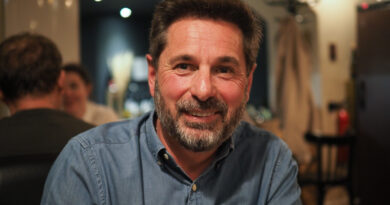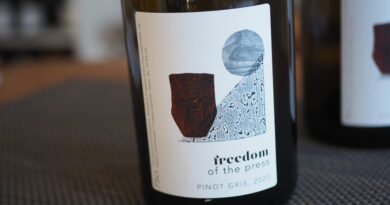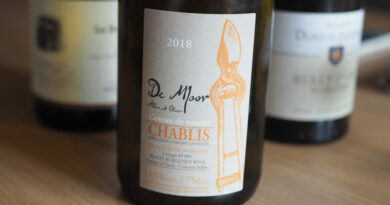Most Memorable Champagnes of 2023
Though Champagne sales fell in 2023 (The Comité Champagne [CIVC] predicted sales of 314 million bottles vs 326 million sold in 2022), Goode and I certainly contributed our share, tasting/drinking a couple hundred bottles between us. Of course much of that was during judging, research, or study, but happily seems a disproportionate amount of our wine budgets is spent on champagne.
While sales were down, the crop was way up in 2023. Record bunch weights averaged 225 grams, nearly 30% heavier than the previous record (175 grams in 2005). This was thanks to a calm spring with little frost damage, followed by a generous flowering period at the beginning of June. However, late summer rains bloated the berries, and sticky heat spells created ideal conditions for botrytis and sour rot, meaning the harvest, officially opened September 2, had to be quick and precise. A heatwave during the first week of September, reaching upwards of 35°C compounded these issues, making sorting, and resorting, essential for harvest 2023. Though I have heard from one grandes marques that they will not be releasing a 2023 prestige cuvée, nimble and focused growers should have a quality vintage, and it will be interesting to see the results of the vins clairs tastings that are underway now. I will be back to Champagne in a couple weeks time and will report back.
Meanwhile, these are our most memorable champagnes of 2023. [TR = Treve Ring; JG = Jamie Goode]

Champagne Pierre Paillard Les Terres Roses Bouzy Grand Cru Rosé XVIII, Montagne de Reims
Brothers Antoine and Quentin Paillard are 8th generation vine growers and winemakers, carrying on the family tradition along with father Benoit. The Paillard family has been growing vines and making wine in Bouzy since 1768, owning only Grand Cru vineyards with old vines via massale selection (no clones). They are truly a star of the grower champagne movement. As the label hints, this GC Rosé is from the 2018 vintage. This year’s blend was 68% Chardonnay, 32% Pinot Noir (5% Bouzy Rouge), a surprisingly high chardy quotient for red-centric Bouzy, though the house norm for Pierre Paillard. There’s a beautiful mix of power and grace here, with a smouldering red fruit, wild herbs, and dried florals against a tight, chalky chardy baseline. A real stunner. 94/100 (TR)

Champagne A. Margaine L’Extra Brut NV, Montagne de Reims
Arnaud Margaine is 5th generation winegrower in the Montagne de Reims, overseeing their sustainable vineyards. This BdB comes from their home village, 1er Cru Villers-Marmery, and parcels Alouettes, Grands Arbres, Levoies. The village is a little island of chalky Chardonnay in an abundant sea of Pinot Noir. This was fermented in an 80/20 SS / wood mix, with no MLF, and approximately 20% reserve wines from the previous year. My bottle spent 2 years sur lattes and was disgorged May 2022, with 3-4 g/L. Tight and racy, with crunchy green apple, bright lemon, and deep chalk streaming along the lifted palate. Beauty Chardy backbone and cut, this is a gem. 93/100 (TR)
Champagne Frédéric Savart L’accomplie 1er Cru Vieilles Vignes Extra Brut NV, Montagne de Reims
Situated 10 km west of Reims, Frédéric Savart is based in the village of Écueil, in the Val de Reims. Continuing from his father’s work with their ‘laboratory of terroirs,’ Savart has made the 4-hectare property his own, and has become one of the superstars of the Grower Champagne movement. So moreish, with bright white cherry, crisp red apple and lively, tight acidity across a deeply chalky base, with a lengthy riffing finish. Very savoury; this is about the place, not fruit. Falling under Freddy Savart’s Vins Singuliers, identitaires, this blend of organically farmed 80% Pinot Noir and 20% Chardonnay comes from Écueil and Villiers-aux-Nœuds and fermented equally in stainless steel tanks on lees, and casks with partial MLF. 30% reserve wines come from the previous two vintages to the base. This bottle was disgorged in November 2021 with 4 g/L. 95/100 (TR)

Champagne Cedric Bouchard VV R20 Roses de Jeanne NV, Côtes des Bar
In the late 1990s, ex-sommelier and visionary Cedric Bouchard took over his father’s vines in the Côte des Bar and established Champagne Roses de Jeanne in 2000. Since the beginning, he embraced single vineyard, single variety, single vintage, 0 dosage Champagnes, all farmed organically. This 2020 Pinot Noir was sourced from the 1.49ha parcel of Val Vilaine in the neighbouring commune of Polisy (hence, the VV in the label). Originally planted in 1974 by Cedric’s father, the vines are 40+ years and grow on bands of Kimmeridgian limestone. The fruit was foot-trodden, and native fermented in tank before heading to bottle and 16 months sur lattes. Beauty structure and presence, with a rimrod limestone backbone basing white cherry, lemon, dried crushed flowers, with a subtle effervescence streaming this to a chalky finish. Certainly not your typical Champagne (blending everything imaginable) this is a very special and singular terroir wine to seek out. 96/100 (TR)

Champagne Taittinger Comtes de Champagne Blanc de Blancs 2011, Côtes des Blancs
Comtes is a remarkable wine, very vintage dependent, but hallmarked with the undeniable finesse of Comtes. This BdB comes from the profoundly chalky GC villages Avize, Chouilly, Cramant, Mesnil-sur-Oger, and Oger. 5% of 2011 has been aged for four months in new oak barrels, one-third of which are replaced yearly. It remained sur lattes for ten years before disgorging with 9 g/L (mostly unfelt up against the tight 2011). Crushed stone, light smoke, deep and damp chalk, meringue strides across a powerful, gently expansive, yet tightly structured palate, lit with lemon pith, anise, green apple and smouldering mineral salts, the latter lingering long on the finish. There’s an impressive density here for all its effortless finesse and lightness. Reminiscent of 2007, but lighter and more fleeting, this is drinking beautifully now. 96/100 (TR)
Champagne Taittinger Comtes de Champagne Rosé 2007
Comtes Rosé is a rare beauty, made only in exceptional years, and representing power x grace. In the 2007, 70% GC Pinot Noir from Montagne de Reims is accented with GC Chardonnay from the Côtes de Blancs). 15% of the PN is still wine from GC Bouzy. Once in bottle, the whole spends 10 years on lees. Now a light negroni hue, this vinous champagne streams wild strawberry, raspberry, cherry, smoked stones long through the structural palate, with a fine chalky base providing an alluring textural riff to the red hewn fruit. The lingering finish trails off into subtle salinity, making this a delight solo, or with food. Very special. 96/100 (TR)
Champagne Pascal Agrapart Minéral Extra Brut Blanc de Blancs Grand Cru 2014, Côtes des Blancs
Founded in 1894, Agrapart has rightfully emerged as one of the finest grower estates in the Côte des Blancs. Pascal Agrapart is the current generation overseeing the estate, making wines since 1984 when he took over from his father, Pierre, and after studying oenology in Bordeaux, and Avize. When he arrived, there were 4 hectares of vines, and he has grown that to 12 hectares, 9 of those rooted in grand cru villages of Avize, Cramant, Oiry and Oger. His father never used herbicides or chemical pesticides, and while Pascal is uninterested in being labelled organic or biodynamic, he follows the same naturalist practices, focusing on the soils. Though not listed on the front, Minéral is a single vintage (check the back label) from two Avize parcels rooted in very chalky soils, and vines 50-60+ years. One vinification is done in old 600L barrels, and the other in tank before a 50/50 blend. This spent 6 years on lees, and was dosed with 3 g/L in March 2021. Alluring toasted hazelnuts, dough, green apple, and lemon peel rule this streamlined BdB, studded with flake salts across a gently expansive meringue core. Avize soils and low dosage give it an electricity that easily tops the weight of wood and time sur lattes, resulting in this beautiful complexity that unravels with time. Another beauty from Pascal. 94/100 (TR)

Champagne Laherte Frères Blanc de Blancs Brut Nature
The Laherte family has a long history in the region. Founded in 1889 by Jean-Baptiste Laherte, the estate was initially made up of vines primarily in the village of Chavot. Fourth-generation vigneron Michel Laherte expanded the family estate, covering about five hectares. With his wife Cécile, the two young vignerons modernized the press and tanks but soon realized that too much modernity, such as herbicides and pesticides, would prevent full terroir expression in the wines. They began working the soils, gently vinifying the juices, and remaining humble and patient as the wines developed. In 2005, his son Aurélien Laherte overtook operations of the estate. The 10.5 hectares of Larherte vineyards are mainly situated in the Coteaux Sud D’Épernay, sandwiched between the Côtes des Blancs and the Vallée de la Marne. Seven of their 75+ separate parcels are farmed biodynamically and certified organic, with the rest organic or sustainably farmed. The Blanc de Blancs come off their chalkiest soils, in Chavot and Epernay, from vines averaging 35 years. It was fermented in small foudres and barrels with light bâtonnage and partial MLF before heading to the bottle for at least 24 months. My bottle was disgorged in July 2021 with zero dosage. At once tight and toasty, with lemon meringue, pencil shavings and crunchy green apple providing ample energy and verve to this BdB. A delight, and one to seek out for those favouring lean, edgy, vibrancy in their BdB. 94 / 100 (TR)
Champagne Egly-Ouriet Grand Cru Brut Tradition NV, Montagne de Reims
One of the forerunners of the grower champagne movement, Egly-Ourier is based in Ambonnay, with 4th generation Francis Egly farming their old vines organically and biodynamically. Brut Tradition (newer labels just say Brut) blends 70% Pinot Noir and 30% Chardonnay, predominantly from Ambonnay with the rest coming from Grand Crus Verzenay and Bouzy. Roughly half is reserve wines, and all was native fermented and aged in barrel (10% new) with no MLF, and it went into bottle unfined and unfiltered. This spent 48 months on lees prior to disgorge with 1 g/L. Pouring a golden hue, this powerful champagne is centred on deep chalk, with savoury lees, strident lemon pith and peel, and wafts of iodine woven throughout. Quite profound, this is a contemplative and uncompromising Champagne. 94/100 (TR)

Champagne Dom Perignon 1992
From the cellar. Now 31 years on, this is still alive, with that exceptional Dom signature presence. Grand Cru Pinot from Aÿ and Bouzy are blended with Chardonnay from Chouilly, Cramant, and Mesnil-sur-Oger, mixing PN power and strength, with Chardy elegance and finesse. This spent 6-8 years on lees prior to disgorge.This changed numerous times throughout the evening, but never disappointed. Light smoked stone, dough, brioche, opens, and then weaves throughout the palate, alongside ample fire toasted marshmallow, caramelized apricot compote, crystalline white honey, wet chalk, and earthy button mushrooms. A fine bead of acidity streams this through an exceptionally long salt studded finish. Impressive for 30+ year old wine. 95/100 (TR)

Champagne Bollinger PN ACY18 NV France
12.5% alcohol. The idea behind this cuvée is to explore the way Bollinger work with Pinot Noir, their main variety. This is 100% Pinot Noir, mainly from Aÿ, but also from Tauxières and Verzenay. The base year is 2018, but it’s a multivintage blend with the oldest vintage 2009 (overall, 47% of reserve wines in the blend, adding a lot of depth and richness). Dosage is 6g/litre. The base vintage was a warm one, with good yields and an early harvest (the first grapes were picked August 15th). Just the best (cuvée) press fraction was used for this wine. It’s a rich, complex Champagne, but shows beautiful balance, with notes of cherry, marzipan, honey, toasted almonds and also some crystalline citrus. Rich and viscous, with a full dynamic range, starting with sweet bass notes of ripe, luxurious fruit and toast, and then finishing with the treble of bright lemons and some lime. Sophisticated and intense, this has so much Pinot personality, so I reckon Bollinger have succeeded with their quest. So compelling and satisfying. 95/100 (JG)
Champagne Taittinger Comtes de Champagne Grand Crus Rosé 2011 France
12.5% alcohol. This is a full coral pink colour. The remarkable thing about this prestige cuvée from Taittinger in 2011 is that it is sweet and savoury at the same time. With 14% red wine in the base wine blend, there’s some structure here, but there’s also a sleek core of sweet strawberry and cherry fruit with a hint of aniseed and some stewed plums, as well as fine dried herb notes and some dusty tannins in the background. There’s some clove and pepper, and these integrate really nicely into the sweet fruit. With some rhubarb notes and sour cherry on the finish, this is really vinous, and superbly gastronomic. There’s also a real sense of sweetness to the fruit. 95/100 (JG)

Champagne Bereche & Fils Ludes 1er Cru Le Cran 2015
Vincent (vines) and Rapha (cellar) are the brothers behind Bereche, which is based in Ludes in the Montagne de Reims. In 2013 they switched from RM (to NM so they could buy grapes from 2 hectares for their Brut Reserve. This is 50% Chardonnay, 50% Pinot Noir from two lieu dits in Ludes (Les Hautes Plantes and St Jean). Both are mid-slope with chalky soils, one facing east, the other west. Most base wines are oak aged. This wine spends over six years on lees and is Extra Brut (disgorged July 2022 with a dosage of 3 g/l). This is remarkable: subtle toast and spice on the nose with a savoury twist to the pear and citrus fruit with a touch of cherry and herbs. Really saline and intense: layered and complex notes of aniseed, cheese and some spicy warmth. Remarkable stuff. 97/100 (JG)
Champagne Agrapart & Fils Avize Grand Cru Mineral 2016
Pascal Agrapart has been running this 12 hectare domaine since 1985. Based in Avize, half his holdings are in the Grand Cru. Mineral is 100% Chardonnay, half from Avize (Le Champ Bouton) and half from Cramant (Les Bionnes). Both are very chalky soils with little top soil. Elevage is a mix of stainless steel and barrels and dosage is 3 g/litre. Taut, lean and quite beautiful with great precision and focus to the lemony palate. Intense and fine, with potential for further development. 96/100 (JG)
Champagne Salon Grand Cru Le Mesnil-sur-Oger 2013
Aged 10 years on lees, disgorged March 2023, dosage 7 g/l. Fine, complex, linear and toasty. This has real impact. There’s a subtle creaminess under the powerful fruit with some refined baked bread and pastry notes, but the emphasis is on powerful lemon and lime fruit, with keen acidity. There’s structure and intensity here, and it’s still unfurled with some green apple notes on the finish, and a tartness. It’s a beautiful wine with a distinctive cool year character, and should age in very interesting ways. 96/100 (JG)
Champagne Jérôme Prévost La Closerie Les Béguines 2020
Based in Gueux in the Marne, Prévost started off with this 1.5 hectare plot, and started making his own wines in Selosse’s cellar in 1998, an arrangement he carried on until 2003. The soils are clay/sand/limestone and this is a blend of 90% Pinot Meunier with the remainder Pinot Noir, Pinot Gris and Chardonnay. The wines are fermented for 10 months in barrel and then just 14-17 months on lees. Dosage is around 2 g/litre. Real complexity here with a fine, vinous quality, and notes of apple, pear and lemons. Quite delicate with great acidity and some notes of cherry. Hints of iodine and minerals on the nose. Layered and fine. 96/100 (JG)

Champagne Guillaume Selosse L’Argillier NV
Guillaume is the son of Anselme Selosse, and began making his own Champagnes (in tiny quantities) in 2009. In 2012 he started making this wine, which comes from a 3.7 hectare monopole in the Aube, planted to Pinot Noir on Kimmeridgean limestone. The base wine is aged for two years in barrel, before being combined with a perpetual reserve and aged another year, and then bottled for tirage. Intense and powerful with notes of cherry, lime and apple. This is just so focused, with a salty edge to the superbly complex fruit. Chalky texture, finishing with a sour cherry edge. Quite special. 97/100 (JG)
Champagne Bruno Paillard Extra Brut Blanc de Blancs Grand Cru MV France
From 36 plots in Oger and Mesnil-sur-Oger, this spends a minimum of 48 months on lees, and this bottle was disgorged in June 2018. 12% alcohol. Pure and very precise with taut lemony fruit. Lovely acid line here with pristine, slightly chalky lemony notes and a subtle crystalline toasty edge. Amazing intensity here. 94/100 (JG)
Champagne Billecart-Salmon Cuvée Nicolas François 2007 France
12.5% alcohol. This is 79% Grands Crus, 21% Premier Crus. 60% is Pinot Noir from the Montagne de Reims and La Vallée de la Marne, and 40% is Chardonnay from the Côte des Blancs. 15% of the wine is barrel fermented in old oak. Dosage is 6 g/litre, disgorged July 2019. This is a powerful wine with aromas of toast, honey, hazelnut and ripe apple, with some cherry and pear. The palate is bold and full, with honey, toast, bread and spice notes as well as some fresh citrus notes accompanying the rich, peachy fruit. Lots going on here: a real impact wine. 94/100 (JG)
Champagne Ayala La Perle 2013 France
12% alcohol. This is the prestige cuvée of Ayala, from Grand Crus (80% Chardonnay from the Côte des Blancs: Chouilly, Cramant, Le Mesnil-sur-Oger; 20% Pinot Noir from the Montagne de Reims: Verzy). aged under cork (agrafe) for 8 years, and hand riddled. Dosage is 6/g/litre. Refined, complex and layered with subtle citrus fruit complemented by toast and spice, and also some richer notes of white peach and pear. Lovely complexity and almost perfect balance, with a touch of cherry on the finish. There’s a gentleness and mellow texture, but it still has energy. 95/100 (JG)




